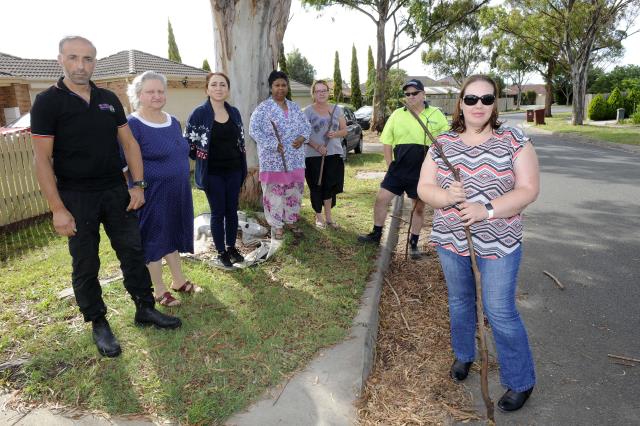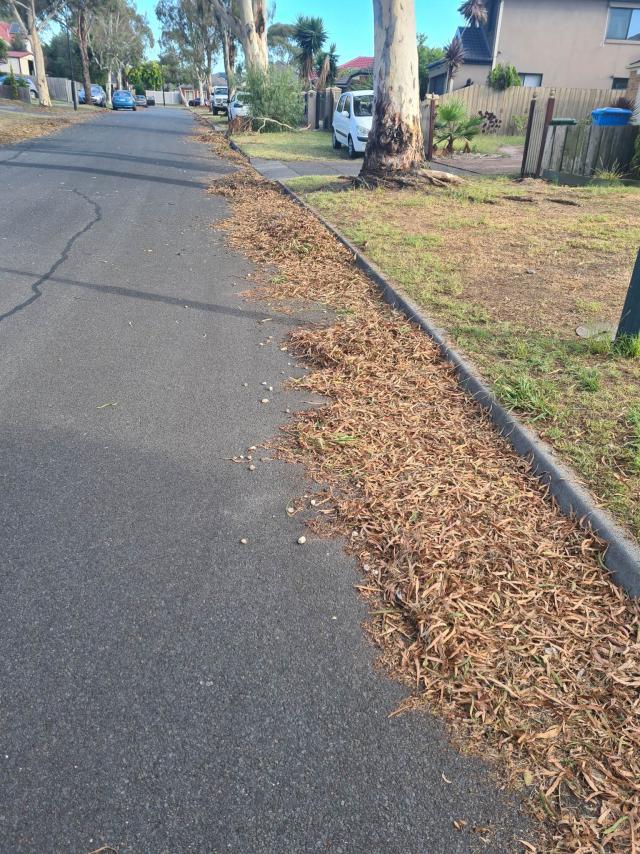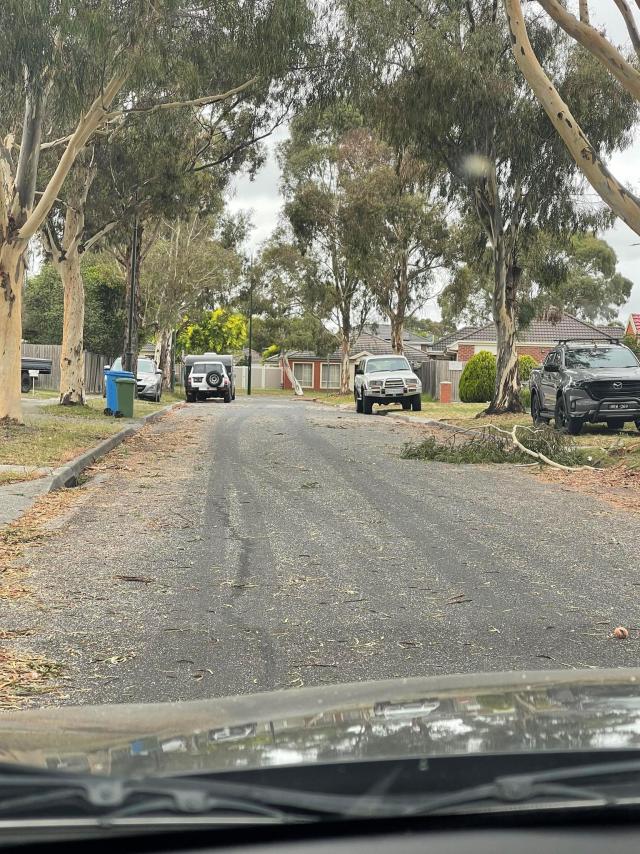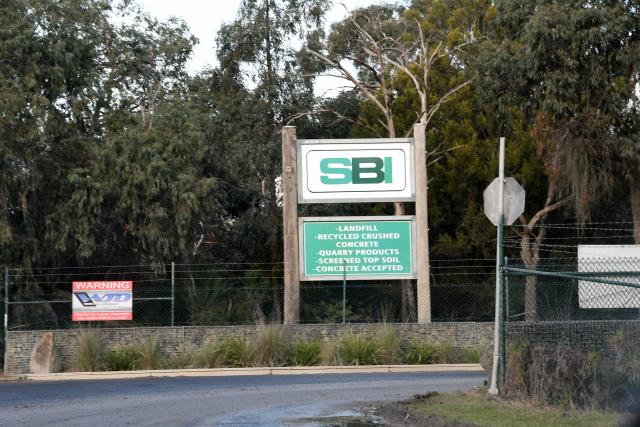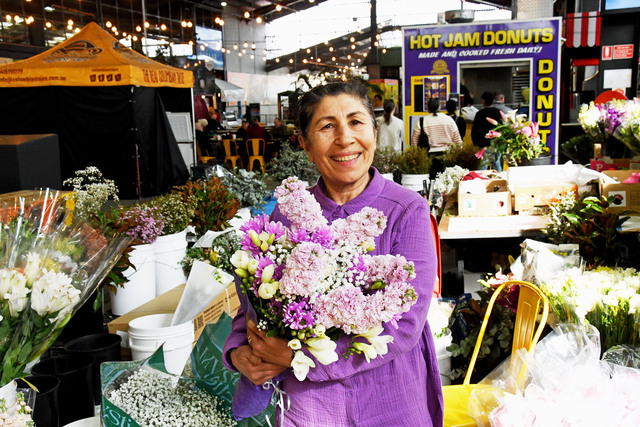The residents of Litchfield Way are buried in leaves and sap sucking insects.
“We cannot have these trees in our street anymore,” said resident Lynne Bolle.
“We’ve all got so much build-up of leaves, it’s an overfill for the garbage.”
“Everyone is just so frustrated,” said Cheree, another resident of Litchfield Way.
Litchfield Way in Lynbrook has been the site of a six-year-long petition by residents to have infested Wallangarra White Gums removed from their street.
The trees are home to an infectious number of insects called psyllids, whose sap draining habits cause the gums to defoliate.
The psyllids also produce white, sticky coverings, called lerps, which residents find are clinging to everything in sight.
“[They] stick to everything, to the cars, to your shoes,” said Brendan Bolle.
“The leaves stick to your feet because they still have the sticky stuff on them.”
The lerps drop in masses upon windshields, with locals in an endless cycle of removing them.
Residents of the Cranbourne East Hunt Club Estate have found themselves at the brunt of this issue over the summer.
“The psyllids have never been present before, this is the first year I’ve seen this,” said Hunt Club resident Kelly.
“But the paths were sticky, the roads are sticky and they stick like crazy to the dogs when walking them.”
After a small triumph in having a small number of problematic trees removed back when the petition began in 2017, the momentum was cut short when Casey councillors were dismissed.
“The agreement was that during [summer] they were going to street sweep regularly and cut the limbs off of the trees that are actually overflowing onto houses,” Cheree said.
The dissolution of the council left the residents of Litchfield Way in the wind.
“We kind of lost traction when the council disappeared,” said Cheree.
Defoliating trees have caused a massive build-up of leaf litter on the local road, as well as blocking drainpipes and gutters.
Moreover, residents’ yards are coated in leaves, and it never ends.
“Even green new leaves are dropping,” said Mr Bolle.
“[The council] admitted they planted the wrong type of gum tree, and it was only our street that has this particular species.
“It takes so much time cleaning them up. It’s out of control.”
On the other side of town, Hunt Club resident Lynn Marsh is likewise finding herself at odds with the falling leaves.
“I arrived home late [Tuesday 28 February] to find the whole street covered literally covered in leaves and branches like a tornado had been through, I’ve never seen it this bad,” she said.
“So many residents here work so hard to keep their front gardens looking gorgeous.
“I do my best but having a huge gum tree out the front I’m fighting a losing battle which does my head in, but it’s so bad this time I need a bob cat to help clean it all up.”
Litchfield Way residents say the council has been lacklustre in their management of the issue, though after being approached for comment by Star News, Litchfield Way was given immediate attention.
“They came around and cleaned up the street today (Friday 10 March) because they knew [a journalist] was coming,” said Mr Bolle.
“They did a really good job, this is the best they’ve ever done it.
“They rang me yesterday (Thursday 9 March) and said they were going to get an arborist and organise a street meeting with the council.
“They did a better job than they have ever done,” said Mrs Bolle.
Despite this prompt resurfacing of the council’s attention, the residents remain exhausted and fed up.
“[Normally] they’ll come out and do it and there will be leaves left everywhere,” said Cheree.
“The wind will blow overnight and it’s like they never did it.”
“It’s going down the drain, it’s on our lawn, it’s all over everything,” said Mrs Bolle.
“Some of the trees are basically empty, they just look terrible, they’re dying.
“It’s not like it’s just happened, it’s been happening for months on end,” said Cheree.
City of Casey manager city presentation, Mardi Cuthbert said: “The trees usually make a complete recovery after a few months, and removal of the trees is not considered necessary in most cases.
“Council has treated and pruned a number of trees, as well as put in place additional street sweeping for streets that have been impacted.
“Residents who are concerned about street trees in their area are encouraged to contact council so that a suitably qualified officer can assess the location, and determine the most appropriate action to improve tree health and street amenity.”
The pain extends beyond the accumulation of leaves and lerps.
Residents fear the gums are doing permanent damage to the structure of their street.
“The roots are growing underneath the concrete, the footpaths are lifting up,” said Cheree.
“We can’t grow grass.
“My neighbour next door has no lawn because the trees are sucking the moisture out of it.
“He literally has a lawn full of leaves.”
“The trees are sucking all of the water out of the gardens and grass,” said Mr Bolle.
“It’s hard to keep your lawn alive,” added Mrs Bolle.
“We often look after [our next door neighbour], doing her lawns but her whole front lawn is dead and it’s just covered in leaves.”
With nowhere to dispose of all of the leaf litter, and quickly filling garden bins, residents have taken to blowing the leaves from their yards back onto the road for the street sweeper.
“We shouldn’t have to be continually doing that,” Mrs Bolle said.
Locals see a clear solution to their strife – cutting the trees down, or, at a minimum, keeping the trees medicated with systemic insecticide as they have been sporadically in the past.
“It’s got to stop one way or another,” Mrs Bolle said.
“It’s not like we hate trees. We love trees, obviously, but not trees that are going to be doing [this], especially when it is the fault of the council.”
“There is no simple solution apart from getting them removed,” said Cheree.
“Medicating them should at least be the bare minimum.”
Mr Bolle has been back and forth with the council via Snap Send Solve, where he had previously posted photos of the mess caused by the trees.
Mr Bolle was sure the photographic evidence would encourage movement on behalf of the council to address the issue, but responses were “hugely disappointing”.
On 6 October 2022, more than five years after the problem was first raised, Mr Bolle received the following message from the council.
“[The insects] usually dissipate in warmer months.
“At this stage we will sit it out and if they are a continuing problem coming into summer then we may have to intervene.”
“By that stage the bugs had gone rampant and the trees were just shedding so many leaves,” said Mr Bolle.
After further complaints from Mr Bolle, the council responded with the following on 15 February 2023.
“It has been an unusually mild summer and after another inspection I have noticed [the insects] are still present.
“If they are still present in the coming months then we may have to take further action.”
With blocked drains causing flooding and piled-up gutters posing a fire risk, Litchfield Way residents feel abandoned by their local government.
“The problem is it’s so expensive to cut them down, [the council] probably haven’t got it in their budget, so they’re poo-poo on that idea,” said Mr Bolle.
“We would be happy to contribute,” Cheree added.
“We’ve been here for a long time and we’re good citizens,” said Mrs Bolle.
“We do all the right things.
“There’s a lot of good people in Lynbrook and the council is just really not looking after us.
“It’s not right.”

